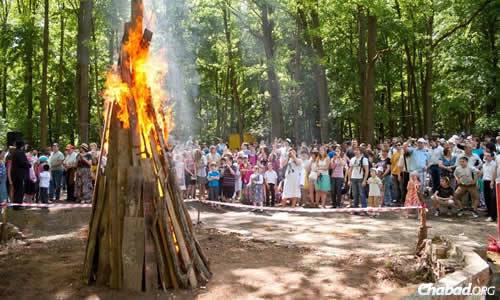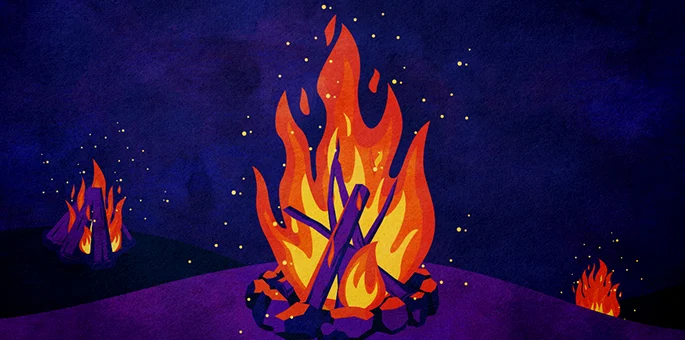Lag B’Omer is a festive day on the Jewish calendar, celebrated for a twofold reason.
The Talmud describes how, during the period of Sefirat HaOmer (the days between Passover and Shavuot), a plague was visited on Rabbi Akiva’s 24,000 students because they did not behave with proper respect for one another. To commemorate the tragedy, certain mourning customs are observed during this time. On the thirty-third day of the Omer count, however, the students stopped dying (lamed-gimmel, pronounced lag, is the Hebrew number 33). The mourning customs are suspended, and we celebrate the day as a holiday.
Lag BaOmer falls on the 18th day of the Hebrew month of Iyar which this year (2024) is on Sunday 26 May.
Lag B’Omer is also the anniversary of passing, several decades later, of the great sage and mystic Rabbi Shimon bar Yochai, best known as the principal author of the Zohar, the fundamental text of Jewish mysticism. The Zohar relates that on the day of his passing, Rabbi Shimon revealed new and profound mystical ideas to his disciples, and commanded them that rather than mourn for him, they should rejoice on this day, just as he rejoiced in his soul’s imminent reunion with G‑d.
All over the world, Lag B’Omer is marked with festive outings and picnics, where children play with toy bows and arrows. In Israel, tens of thousands gather in the small Upper Galilee village of Meron to celebrate at Rabbi Shimon’s gravesite. The night is lit up by bonfires of all sizes; the singing and dancing is a sight to behold.
A custom, practiced especially in Meron and throughout Israel, is to light bonfires on the night of Lag B’Omer.

One explanation for the custom is that on the day of a tzaddik’s passing, all the holy work he has done culminates and is revealed in this world. On Lag B’Omer, the true power of Rabbi Shimon’s accomplishments as one of the foremost Talmudic sages and the author of the Kabbalah shone forth.
In fact, it is recorded in the Zohar that the overwhelming deluge of spiritual light had such a potent effect on the world that the sun did not set until Rabbi Shimon had finished conveying his wisdom and passed on, and that a spiritual fire surrounded his deathbed the entire day. We light fires to commemorate the spiritual revelation that occurred on this day.
Many have a custom to give children toy bows and arrows to play with at Lag B’Omer picnics. One explanation for this custom is that as a result of Rabbi Shimon’s great merits, no rainbow was seen during his lifetime. (According to Torah, the rainbow is a sign of G‑d’s displeasure.) We play with bows to commemorate this miracle.
Beginning in the 1950s, the seventh Lubavitcher Rebbe, Rabbi Menachem Mendel Schneerson, encouraged Jewish children to join in grand Lag B’Omer parades as a show of Jewish unity and pride. Held in front of the Lubavitch world headquarters in Brooklyn, New York, the parades attracted—and still attract—thousands of children from all walks of life.
In accordance with the Rebbe’s general instruction that any gathering of Jews should be connected with Judaism and Torah, the children would recite the 12 Torah passages selected by the Rebbe as containing the most fundamental ideas in Judaism, before the parades began. The floats displayed Jewish themes, and the parades were followed by festivities for the entire family.
Often the Rebbe spoke at the parades, sometimes addressing current world events. A well-known example of this was the 1967 parade, when the Rebbe spoke about the crisis happening in the Middle East. He issued a call to increase in the fulfilment of the Torah as a medium for expanded divine blessings for the Jewish people, and predicted that a great miracle would shortly happen. He stood out as one of the few Jewish leaders to anticipate Israel’s victory in the Six-Day War.
In 1980 the Rebbe gave instructions that Lag B’Omer parades and children’s rallies should take place not only in New York, but across the world, especially in Israel. Thousands of children participated in the tens of rallies that took place that year, and until today Chabad organizes hundreds of Lag B’Omer parades around the world each year.
Perhaps the most important lesson the holiday has to offer is expressed in a letter the Rebbe wrote to all Jews in honour of Lag B’Omer 1974. When one examines Rabbi Shimon’s life, he writes, one sees that there were two focal points around which it revolved: Torah study and love of fellow Jews. Although not everyone can study Torah as an exclusive occupation, as Rabbi Shimon did, everyone can and should set aside times each day to devote solely to Torah study without any outside interference. This should be permeated with a sense of Ahavat Yisrael—love of a fellow Jew—which will bring them to encourage others to follow suit.
By fulfilling this directive, may we merit to experience a time when there will be only light in the world, and G‑d’s presence will be visible and tangible to all mankind.



